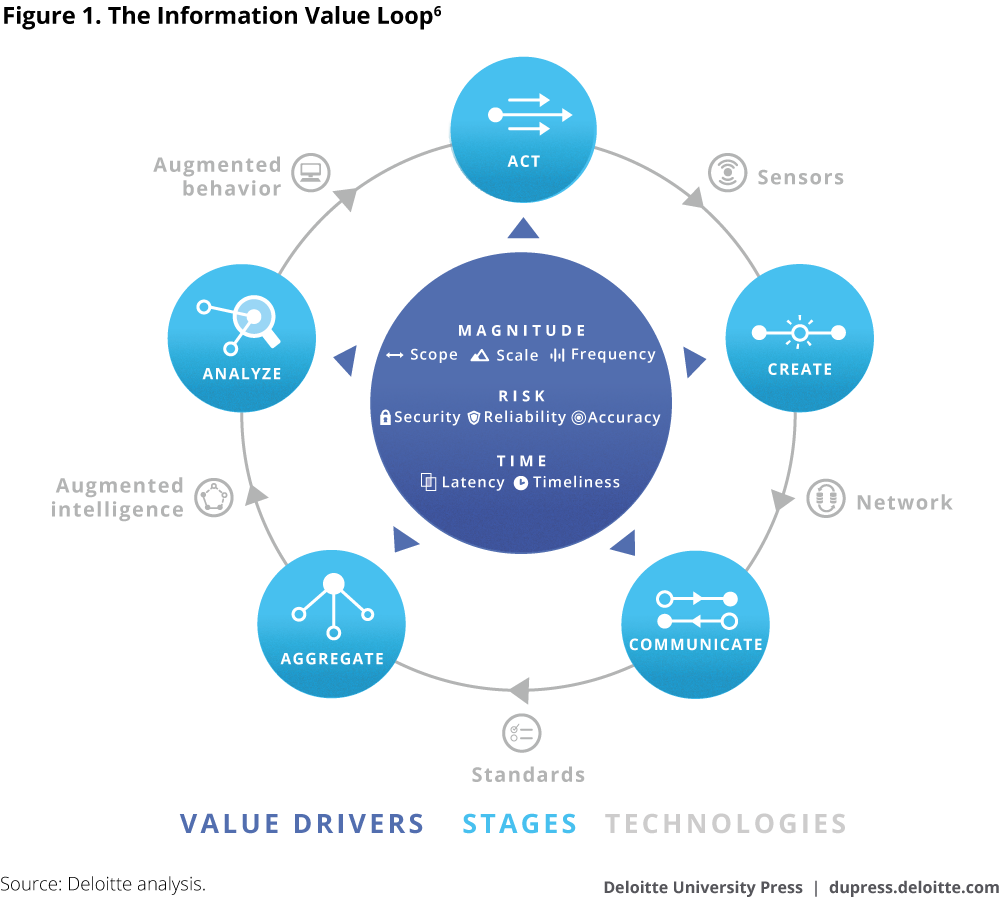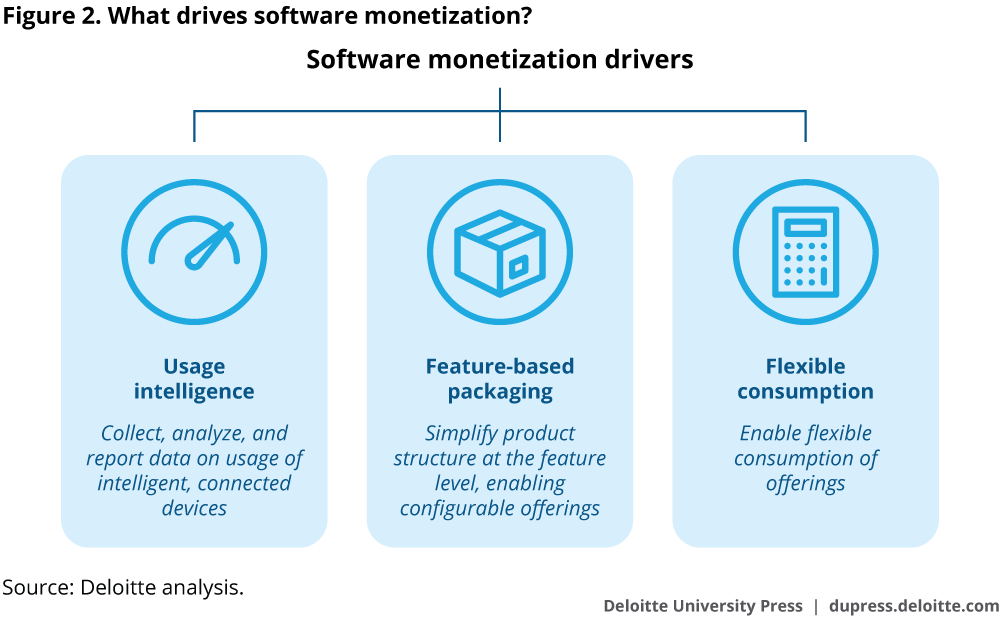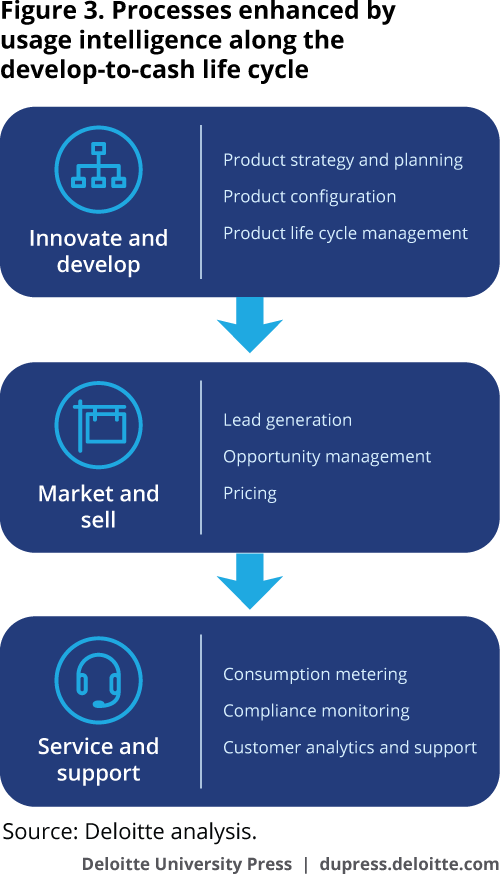Turning value into revenue has been saved

Turning value into revenue What IoT players can learn from software monetization
17 November 2016
 Ayo Odusote United States
Ayo Odusote United States Sujit Naik United States
Sujit Naik United States Ashish Tiwari United States
Ashish Tiwari United States Gary Arora United States
Gary Arora United States
Customers want connected technology, but can companies make any money from the Internet of Things? The answer is yes—and the software industry offers a possible model for finding revenue in IoT-based products and services.
Introduction: The software model’s hard-dollar lessons
We’ve all read plenty about the rise of the Internet of Things (IoT), including its exponential growth. The number of connected devices alone is expected to explode in the next few years, with forecasts for new devices by 2020 ranging from 20 billion to more than 200 billion.1 Analysts predict that IoT technology will support $235 billion in spending on services alone in 2016, mostly on professional services to design, install, and operate systems.2 As these intelligent, connected devices proliferate across industries, the growth of data will offer tremendous opportunities for direct and ancillary services.
With all that growth and spending, many companies are struggling to settle on the right IoT application or justify the capital investment that the technology may require. In many cases, this difficulty is due to the fact that, while it may be clear how connected technology can save money—by, for instance, making operations more efficient or allowing workers to do more3—it’s often less obvious how IoT applications might generate new revenue, in either the short or long term.4
Indeed, for many executives, the idea of locating value in the combination of physical and digital information is still new. In this article, we look specifically at monetizing IoT technology, exploring strategies common in the software world—where information has long generated value—and how those strategies may apply in a connected world.
Capturing value
In the simplest form, IoT technology takes inputs from the physical world, uses digital technologies to derive insights from those inputs, and then makes outputs available for use back in the world. In linking the physical and digital world, the IoT has another impact as well. Traditional physical products create value for customers only by virtue of their performance: A standard lightbulb is valuable based on its brightness, efficiency, and lifespan. With connected objects, information also becomes a key determinant of value: A smart lightbulb is valuable not just because it can brighten a room but because it can enable automation, scheduling, remote controlling, and other abilities.5
Every action of an IoT-enabled device creates new information that can be communicated, aggregated, analyzed, and acted upon. Deloitte’s Information Value Loop (see figure 16) illustrates how companies can harness this flow of information to create and find value in IoT technology. As information moves around the Value Loop, it creates value for customers and companies.
For information to complete the loop and create value, it passes through the stages of the loop, each stage enabled by specific technologies. An act is monitored by a sensor, which creates information. That information passes through a network so that it can be communicated, and standards—technical, legal, regulatory, or social—allow that information to be aggregated across time and space. Augmented intelligence is a generic term meant to capture all manner of analytical support, which collectively is used to analyze information. The loop is completed via augmented behavior technologies that either enable automated autonomous action or shape human decisions in a manner that leads to improved action.

How to capture IoT value?
In modeling information flow, the Value Loop can illustrate just how IoT technology can create value for customers and companies. Since creating and capturing value are central to any company’s strategy, the loop serves as an important tool for executives to understand what an effective business strategy might be in the IoT ecosystem. Due to the merger of physical and digital, IoT applications are creating market opportunities in ways that are both unexpected and unfamiliar.7
Perhaps as a result of this unfamiliarity, many leaders are taking a wait-and-see attitude toward IoT technology, despite its accelerating adoption. A recent MIT and Deloitte survey of IT executives revealed that most of their companies intend to leverage IoT-generated data to pursue only small-scope applications aimed at efficiency improvement.8 While it is certainly prudent to start small and scale applications as they succeed, thinking big is also a benefit. For businesses that need to rationalize initial tech investments, using IoT technology to generate revenue may be the key. However, currently few executives anticipate quick moves toward larger-scope IoT applications aimed at creating new revenue.
The cumulative result of aiming at mostly small-scale efficiency gains: Executives often cannot readily envision monetizing IoT-based projects.9 IoT applications have sparked innovation across industries, but adoption still lags behind some of the most optimistic projections of analysts. Connected technology likely will not reach its transformative potential until paths to generating revenue become clearer. Research indicates that, whether they produce hardware or seek to apply IoT technology, the majority of companies are not generating service revenues from their solutions, and a number of firms even fail to leverage insights from the customer data that they do have.10
However, this hardly means that companies shouldn’t aim for their IoT applications to generate revenue. On the contrary, by highlighting a few general strategies for monetizing information, this article will show several IoT projects already generating net new revenue—and in the process open a possible set of paths forward.
Using software as a model
If information is what generates IoT value, then the key to monetizing connected technology may be expected to lie in the data that technology generates. Turning data into money is not necessarily a straightforward process: It requires knowledge of customers, and the governance capabilities to take advantage of that knowledge, to be able to offer the right item to the right customer in the right way. To develop these data governance capabilities, IoT players can learn from an industry in which information has long been a primary source of value—software—and explore the monetization drivers that leading firms are leveraging.
In the software world, selling technology has evolved from selling packaged software to selling services, building relationships focused on driving value to customers, and meeting customers’ expectations for flexibility in consumption.11 From a monetization perspective, this means that new business models are expanding and becoming the norm. For instance, the online file-sharing and content management service Box follows the “freemium” model: A free service includes a personal account with limited storage and file size, while the premium service, aimed at businesses, allows more storage, bigger file size, more users, enhanced collaboration, security and administrative features.12 For its Creative Cloud, Adobe offers monthly subscription plans limited by various levels of storage and number of available desktop and mobile applications; tiers are defined for different levels of consumption and customer type (for example, individual, student, teacher, corporate).13 Other models in the software sector employ pay-per-use (also known as utility) models, and outcome-based models focused on the business value that the product or service delivers.14
All of these techniques can be grouped into three key monetization drivers—usage intelligence, feature-based packaging, and flexible consumption—that form the foundational pillars of top software firms’ monetization strategy. (See figure 2.) Executives in other industries can look to these pillars in developing strategies of their own. After all, many companies have little direct experience deriving revenue from customer-generated data, and effectively packaging and pricing products and services can prove challenging.15
To help illustrate each of the three monetization drivers, we identify one “learning from software” example for each monetization driver, showing how each has traditionally been put to use by software companies. We then pair that example with an “IoT case study” describing how that same driver appears in an IoT context.

Usage intelligence
Usage intelligence refers to the capability to collect, analyze, and report data about how the customer uses an intelligent, connected device; this capability helps in generating actionable data-based insights. In the software world, usage intelligence has a specific meaning: It generally refers to the intelligence regarding which product features a customer uses, and how often. In an IoT context, we see it taking on a broader meaning and includes a range of behavioral information on how a customer uses a product, including structured and unstructured data on the relationship between the customer, the product, and the broader ecosystem.

To software customers, usage intelligence provides greater visibility into their licenses, entitlements, and consumption patterns, enabling them to make informed choices about their usage of a software product. For IoT players, intelligence-generated information can help to generate revenue throughout the develop-to-cash life cycle (see figure 3). In the development phase, the data can help improve the next version of the product by prioritizing the features that consumers value most. In the sales-related phases, the data can help uncover potential sell, upsell, and cross-sell leads. In the support phase of the cycle, this data further provides insights for customer service and support and predictive maintenance, creating numerous opportunities to differentiate the product from competitors.
As companies look at the option of deploying usage intelligence, they need to ensure availability of the following supporting capabilities:
- Connectivity to send information to devices and back office via networking protocols
- Management of all sources of relevant structured and unstructured usage data
- Reporting and visualization to report on usage to customers and business through user-friendly interfaces
- Advanced analytics to mine data in real time and predict future behavior based on past usage patterns
Learning from software: Leading data storage provider
Industry: Technology infrastructure and services16
Annual revenues: $20–50 billion
Issue: Focusing on data storage, the company had originally made money from the hardware used to store data, such as drives and tape. However, recent years had seen a perceptible shift in value away from hardware and toward software. With the commoditization of hardware, the company’s storage hardware business faced decreasing margins, and the company was looking to develop advanced software management capabilities to transition its business toward a software-centric model.
Solution: The company invested in usage intelligence capable of collecting information about how much of the software a customer used. The data would support several important tasks within the business: sales, to inform the sales reps about the customer’s past consumption behavior; renewals, to inform reps of upcoming opportunities to renew the offer; and compliance, to alert the compliance team to cases of over-deployment of purchased software and others.
Impact: The company expects to achieve $400 million in revenue increases over a five-year span from increased upsell/cross-sell sales, improved maintenance renewal rate, and higher revenue capture from license over-deployment. The company is currently on track to meet its strategic imperative of becoming a software-led business.
IoT case study: How Streetline implements usage intelligence
Streetline, operating in 30 cities across the United States, United Kingdom, and Germany, is focused on the Smart City movement. It is helping address the urban resource problem of parking availability by delivering real-time intelligent data and advanced analytics to consumers.
Issue: For managers of urban resources, this turf is a blind spot. There is no real-time data about how parking gets used, and it is difficult to manage what you can’t measure. Experts believe that about 30 percent of urban traffic consists of drivers hunting for parking spaces, which generates a significant amount of CO2 emissions adding to health and environmental issues.17
Solution: Streetline has implemented usage intelligence by being able to collect and monetize unstructured data. The firm is able to collect and collate numerous types of data from in-ground sensors to traffic cameras to Wi-Fi connections, piecing together this information to create a map of parking spaces and signaling whether spots are occupied or vacant. Over time, the accumulated data will reveal local parking patterns, allowing cities to price parking spaces according to their actual value, factoring in supply and demand as they would with any other piece of real estate.
With that data, cities can help reduce congestion by guiding drivers to the nearest available parking space. Streetline’s real-time and historical applications enable cities to use data to improve parking planning and policy. With its intelligent parking solutions, the company is helping cities reduce emissions, better manage parking, and reduce urban traffic.18
Monetization strategy: Streetline uses this information to earn revenue from both the municipal governments and drivers using the service. For individuals, Streetline is able to harvest the data from people using the app to find parking, thus improving the overall accuracy of the system’s parking maps. For municipalities, there is a monthly service fee along with an up-front installation cost of about $200 per parking space to install a wireless sensor that tells the city government whether a vehicle is parked there. Municipalities can recoup these costs through more efficient management of city parking.19
Feature-based packaging
Feature-based packaging refers to companies’ ability to provide flexible offerings by allowing customers to configure their products, enabling or disabling features as desired. With IoT applications, this becomes particularly important because companies are no longer locked into selling a single product but, rather, can sell that same product in several different ways based on the combination of features offered to the customer. In fact, those product features can even change over time through over-the-air updates or purchases. By offering many different versions of a product at different price points, a company can capture a greater share of the market—and therefore increase its revenues.20
While feature-based packaging has traditionally been highly popular in the virtual goods market, it has started gaining traction among industrial machinery and durable goods companies as well. For example, one manufacturer of electric vehicles is now able to send over-the-air software updates that add new features and functionality to its cars, and allows customers to purchase software-based upgrades to unlock some of the functionalities that are already available in their cars. For $8,500 above the purchase price, customers can choose an upgraded version, which can travel about 40 more miles per charge without the need of changing hardware or even taking the car to the service center. The manufacturer can simply flip the software switch remotely.21
Feature-based packaging offers customers the flexibility to configure and personalize services, and enables companies to diversify offerings, helping improve monetization potential. At the heart of feature-based packaging sits entitlement and license capabilities that enforce and adapt the usage policies appropriate to each individual user. In particular, entitlement management automatically creates and manages electronic records for each user’s entitlements to certain features, while license management locks or unlocks features per entitlements to enforce usage compliance.22 An additional capability needed to enable feature-based packaging is product configuration that provides the ability to customize offerings by configuring at the lowest level of service or features.
Learning from software: Medical technology company moving to as-a-service model
Industry: Medical device manufacturing23
Annual revenues: $5–10 billion
Issue: The company was an established medical device manufacturer that understood software’s importance to the future of the industry. However, the fragmentation of technology left the company struggling to provide seamless packages of medical software and hardware. In a field where precision and ease-of-operation are mission critical, customers demanded flexibility in the way they consume medical solutions.
Solution: The manufacturer responded to customer concerns by investing in a software-based licensing capability in portable imaging devices to provide flexible packaging options. A purchaser would be able to unlock specific features based on the type of physician using the device and the type of scans or images that needed to be captured.
Impact: The investment had a strategic impact on the company, turning their hardware products into software-as-a-service (SaaS). Customers embraced the new flexibility provided in the way solutions were packaged, setting the company on a transformation path to a services-based model.
IoT case study: How Nexia implements feature-based packaging
Nexia focuses on home automation systems, offering solutions for controlling smart-home devices such as locks, sensors, lights, thermostats, and video cameras.
Issue: Home automation has been a fragmented industry, with multiple standards and frameworks competing to augment manufacturers’ proprietary ecosystems. The lack of integration across technologies and devices has necessitated workarounds, complicating home automation and limiting industry growth.
Solution: Nexia employs an open architecture that supports more than 230 different types of devices across manufacturers. The company designed an interface that focuses on user behavior and features so that homeowners do not have to deal with the complexity of integrating different devices.
In doing so, Nexia implemented feature-based packaging by providing a huge selection of compatible products across manufacturers as components that can be integrated like building blocks. Consumers need purchase only those blocks that they want to use; they can upgrade to add more blocks anytime, increasing both the value to the customer and the revenue opportunities for the company.
Monetization strategy: The initial cost is a start-up kit that includes the Nexia Hub and a dimmer module. From here, consumers can customize their experience with an à la carte selection of add-ons across various categories such as security, climate, lighting, energy, garage, and water. These add-ons can be bought together or separately and can be further packaged into combinations of features and manufacturers.24
Flexible consumption
The third driver, flexible consumption, refers to customers’ ability to consume and pay for a service or product based on need and usage. Flexible consumption uses the same data on product usage as usage intelligence, but rather than using that information to improve the product’s next iteration, flexible consumption offers customers the option to pay for only what they have gotten from the product. Pricing can be strictly usage-based, such as subscriptions or pay-as-you-go, or outcome-based, in which customers pay based on the product’s performance. Outcome-based pricing is especially applicable in industrial scenarios, where IoT products are priced based on the operational efficiency improvements that the end user realizes.
Flexible consumption models enable recurring revenue streams and help align business needs with customer preferences. Similarly, when customers desire a new function or capability, they need not go back to the open market to find a new product—they can simply upgrade their existing product (thereby locking them in). To offer such a model, companies will need to improve some of their core business functions to ensure that they are capable of supporting flexible pricing of software and service to customers:
- Order management and customer care functions should be able to manage orders under flexible models throughout the customer life cycle.
- Pricing and deal analytics capabilities should be developed to prioritize deal variables and design pricing models.
- Billing policies and infrastructure should be upgraded to support invoicing and billing for subscription and pay-per-use consumption.
- Revenue allocation function should be able to recognize and allocate revenue based on flexible and recurring schedules.
Learning from software: Leading global SaaS company
Industry: Technology25
Annual revenues: $20–50 billion
Issue: A leading software company had built its name on selling software directly to companies for their ownership and use on premise, making money with yearly upgrades adding new features. However, the company faced decreasing sales of its on-premise software portfolio, and executives saw the existing business model as running out of steam: Customers would no longer want to pay for incremental upgrades, and the products were thought to be “good enough” already. One approach for the company would have been to admit that the business was low- to no-growth and accept a small, steady revenue stream. Another was to transform it into a growth business.
Solution: The company looked to test whether the business could be turned into a high-growth venture and decided to transition to a flexible consumption model to ride the tide of business model innovation already present in the market. The company thus rolled out cloud-based versions for the majority of its portfolio and set up a subscription model under which to sell these versions. Rather than selling a stand-alone box of software to a customer, the company was able to offer continuing subscriptions to an ever-changing catalog of software. This gave customers the benefit of always having the most up-to-date software, and the company the benefit of having a growing source of new revenue.
Impact: With the majority of the portfolio transitioning to subscription and the growth of the new subscription business, the company has since become one of the most successful SaaS providers in the space.
IoT case study: How Kairos implements the flexible consumption model
Kairos is a human analytics platform that allows data-driven companies to build products that recognize, understand, and respond to people.
Issue: The real-time metrics generated from emotion analysis, facial recognition, and crowd demography can be a game-changer for data-driven industries such as advertising, retail, banking, gaming, security, and surveillance. But humans are multidimensional and sophisticated, making capturing and making sense of this data an arduous process.
Solution: Kairos created an algorithm that makes it possible to capture decisive moments in people's behavior to empower companies with meaningful metrics. The company captures three-dimensional data that measures people’s feelings and interactions. Understanding how people feel as they interact with content, products, and the real world provides a layer of clarity to data that was previously unavailable.
Their technology uses cameras as an emotion-aware device to recognize and understand how people feel in video, photos, and the real world.
Monetization strategy: Kairos has implemented flexible consumption models by enabling multiple ways to consume and price its services:26
- The company’s facial recognition feature is consumed via API and metered on the number of monthly API calls in the denomination of 5,000 ($0), 10,000 ($149), 100,000 ($449), 500,000 ($1,499), and 1,000,000 ($2,500).
- Its emotion-analysis feature is metered on monthly minutes of analyzed video in the denomination of 30 minutes ($0), 200 minutes ($249), 500 minutes ($449), 2,000 minutes ($1,499), and 4,000 minutes ($2,500).
- The company’s crowd demographic plan is metered on the number of connected devices and licenses.
Conclusion: Driving to monetization
IoT technology is forcing many older companies into unfamiliar places, and one of the least comfortable is the idea that user-generated data—and the software necessary to process that data—may be key to future business plans. Many sectors have few established examples of mature companies making the transition to being data-driven, including developing new ways to generate revenue.
But while many new IoT players are adjusting to a world in which information creates value, leading software companies have been living in this world for years. Today, they are leveraging usage intelligence, feature-based packaging, and flexible consumption as part of their monetization strategies to use information to generate more revenue. Given the information-centric nature of connected products, IoT players can realize the monetization potential of their offerings by investigating these drivers. Whether adopting one, two, or all three of these drivers, an integrated approach to looking at these monetization strategies could help companies maximize their value capture from their IoT offerings and build a sustainable competitive advantage.
So how can companies determine which monetization strategies are right for them?
- As a first step, IoT players should develop business use cases for each monetization driver at every stage of the develop-to-cash life cycle.
- Companies can then evaluate use cases based on their potential revenue impact and investment requirement.
- Finally, companies should also analyze the process and policy impact of the identified use cases to uncover potentially hidden costs or risks before beginning any implementation.
With these relatively simple steps, IoT players can advance confidently into the previously unfamiliar ground of information-based monetization strategies so far found more typically in the software world. Armed with these strategies, IoT players can overcome the hurdles that have often limited IoT applications, and begin to use connected technology not just to save money but to generate new value for customers and new revenue for companies.
© 2021. See Terms of Use for more information.




